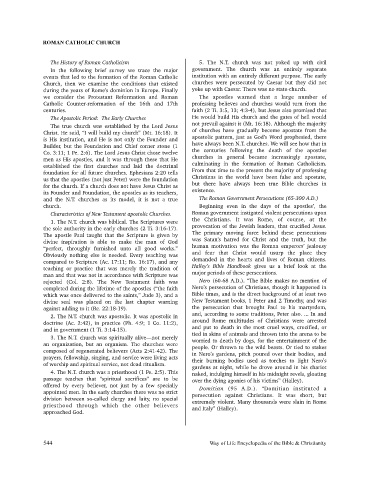Page 544 - Way of Life Encyclopedia of the Bible Christianity. Based on the King James Bible
P. 544
ROMAN CATHOLIC CHURCH
The History of Roman Catholicism 5. The N.T. church was not yoked up with civil
In the following brief survey we trace the major government. The church was an entirely separate
events that led to the formation of the Roman Catholic institution with an entirely different purpose. The early
Church, then we examine the conditions that existed churches were persecuted by Caesar but they did not
during the years of Rome’s dominion in Europe. Finally yoke up with Caesar. There was no state-church.
we consider the Protestant Reformation and Roman The apostles warned that a large number of
Catholic Counter-reformation of the 16th and 17th professing believes and churches would turn from the
centuries. faith (2 Ti. 3:5, 13; 4:3-4), but Jesus also promised that
The Apostolic Period: The Early Churches He would build His church and the gates of hell would
The true church was established by the Lord Jesus not prevail against it (Mt. 16:18). Although the majority
Christ. He said, “I will build my church” (Mt. 16:18). It of churches have gradually become apostate from the
is His institution, and He is not only the Founder and apostolic pattern, just as God’s Word prophesied, there
Builder, but the Foundation and Chief corner stone (1 have always been N.T. churches. We will see how that in
Co. 3:11; 1 Pe. 2:6). The Lord Jesus Christ chose twelve the centuries following the death of the apostles
men as His apostles, and it was through these that He churches in general became increasingly apostate,
established the first churches and laid the doctrinal culminating in the formation of Roman Catholicism.
foundation for all future churches. Ephesians 2:20 tells From that time to the present the majority of professing
us that the apostles (not just Peter) were the foundation Christians in the world have been false and apostate,
for the church. If a church does not have Jesus Christ as but there have always been true Bible churches in
its Founder and Foundation, the apostles as its teachers, existence.
and the N.T. churches as its model, it is not a true The Roman Government Persecutions (65-300 A.D.)
church. Beginning even in the days of the apostles’, the
Characteristics of New Testament apostolic Churches. Roman government instigated violent persecutions upon
1. The N.T. church was biblical. The Scriptures were the Christians. It was Rome, of course, at the
the sole authority in the early churches (2 Ti. 3:16-17). provocation of the Jewish leaders, that crucified Jesus.
The apostle Paul taught that the Scripture is given by The primary moving force behind these persecutions
divine inspiration is able to make the man of God was Satan’s hatred for Christ and the truth, but the
“perfect, throughly furnished unto all good works.” human motivation was the Roman emperors’ jealousy
Obviously nothing else is needed. Every teaching was and fear that Christ would usurp the place they
compared to Scripture (Ac. 17:11; Ro. 16:17), and any demanded in the hearts and lives of Roman citizens.
teaching or practice that was merely the tradition of Halley’s Bible Handbook gives us a brief look at the
man and that was not in accordance with Scripture was major periods of these persecutions.
rejected (Col. 2:8). The New Testament faith was Nero (60-68 A.D.). “The Bible makes no mention of
completed during the lifetime of the apostles (“the faith Nero’s persecution of Christians, though it happened in
which was once delivered to the saints,” Jude 3), and a Bible times, and is the direct background of at least two
divine seal was placed on the last chapter warning New Testament books, 1 Peter and 2 Timothy, and was
against adding to it (Re. 22:18-19). the persecution that brought Paul to his martyrdom,
2. The N.T. church was apostolic. It was apostolic in and, according to some traditions, Peter also. ... In and
doctrine (Ac. 2:42), in practice (Ph. 4:9; 1 Co. 11:2), around Rome multitudes of Christians were arrested
and in government (1 Ti. 3:14-15). and put to death in the most cruel ways, crucified, or
3. The N.T. church was spiritually alive—not merely tied in skins of animals and thrown into the arena to be
worried to death by dogs, for the entertainment of the
an organization, but an organism. The churches were people. Or thrown to the wild beasts. Or tied to stakes
composed of regenerated believers (Acts 2:41-42). The in Nero’s gardens, pitch poured over their bodies, and
prayers, fellowship, singing, and service were living acts their burning bodies used as torches to light Nero’s
of worship and spiritual service, not dead ritualism. gardens at night, while he drove around in his chariot
4. The N.T. church was a priesthood (1 Pe. 2:5). This naked, indulging himself in his midnight revels, gloating
passage teaches that “spiritual sacrifices” are to be over the dying agonies of his victims” (Halley).
offered by every believer, not just by a few specially Domitian (95 A.D.). “Domitian instituted a
appointed men. In the early churches there was no strict persecution against Christians. It was short, but
division between so-called clergy and laity, no special extremely violent. Many thousands were slain in Rome
priesthood through which the other believers and Italy” (Halley).
approached God.
544 Way of Life Encyclopedia of the Bible & Christianity

